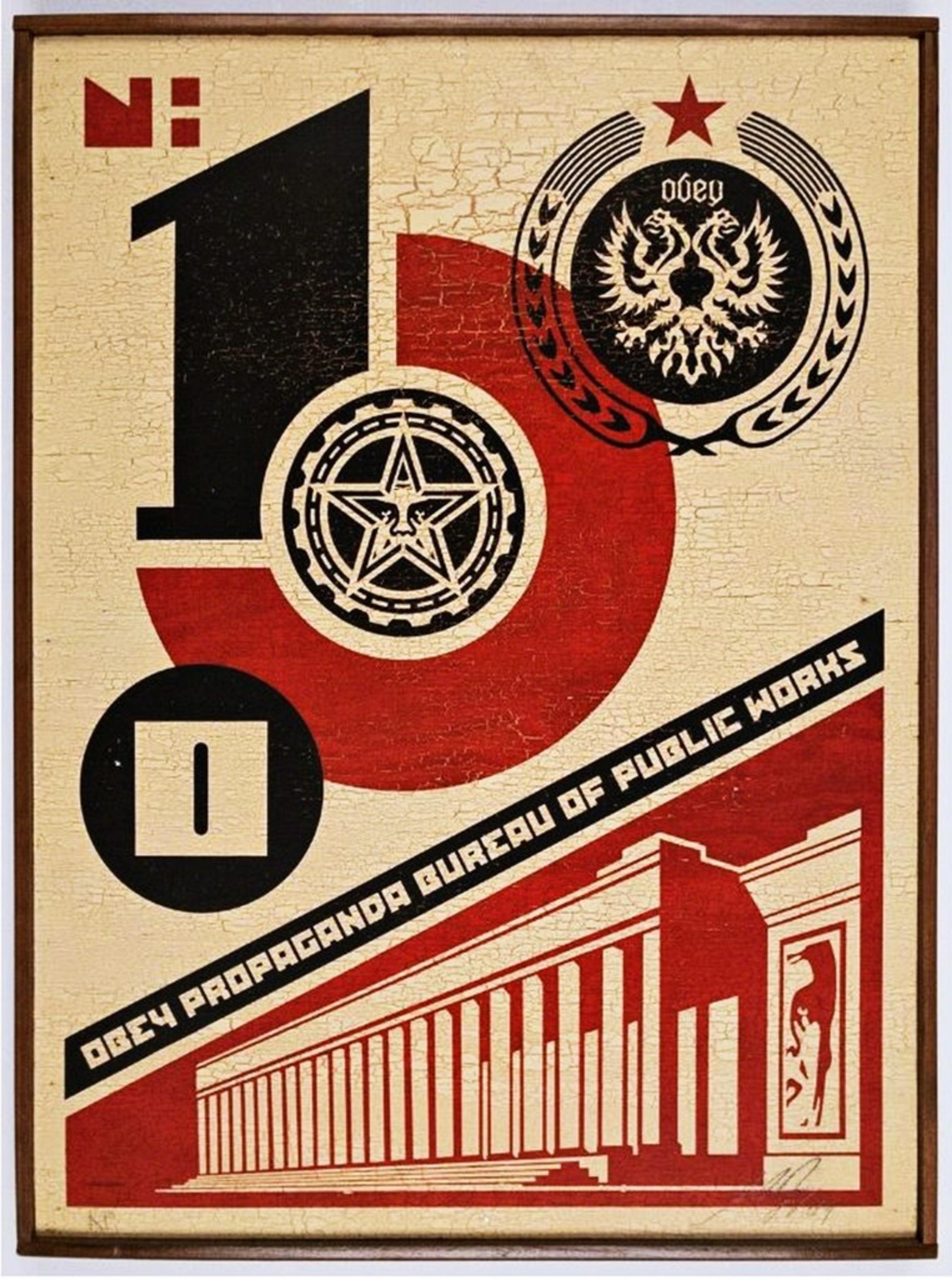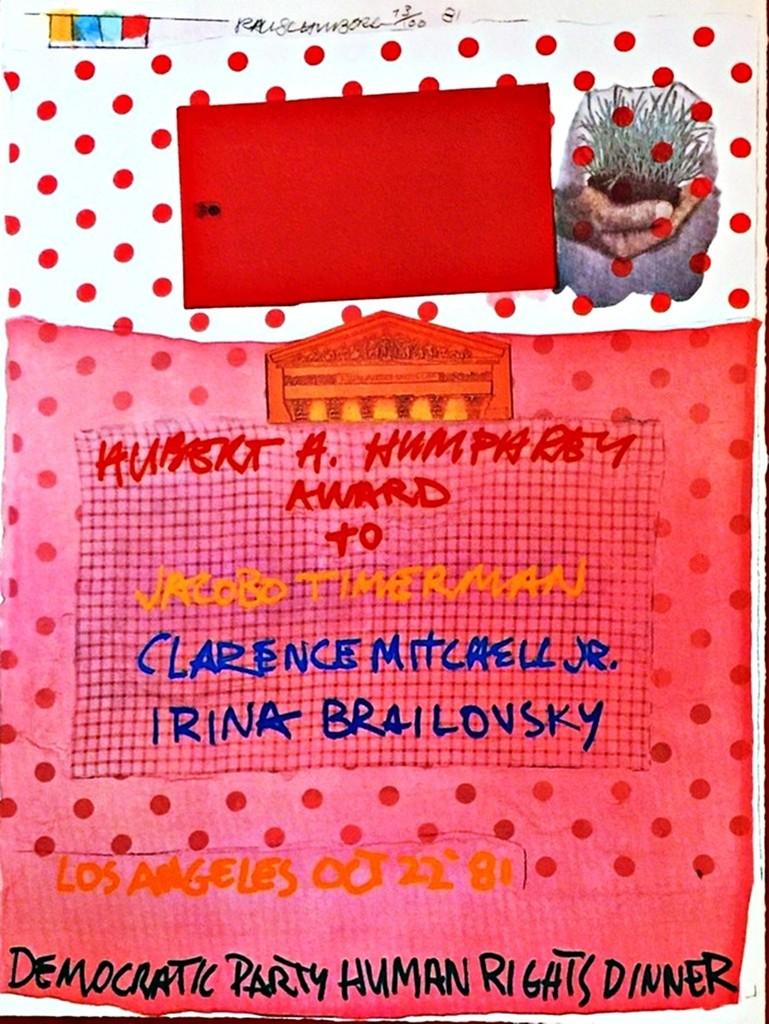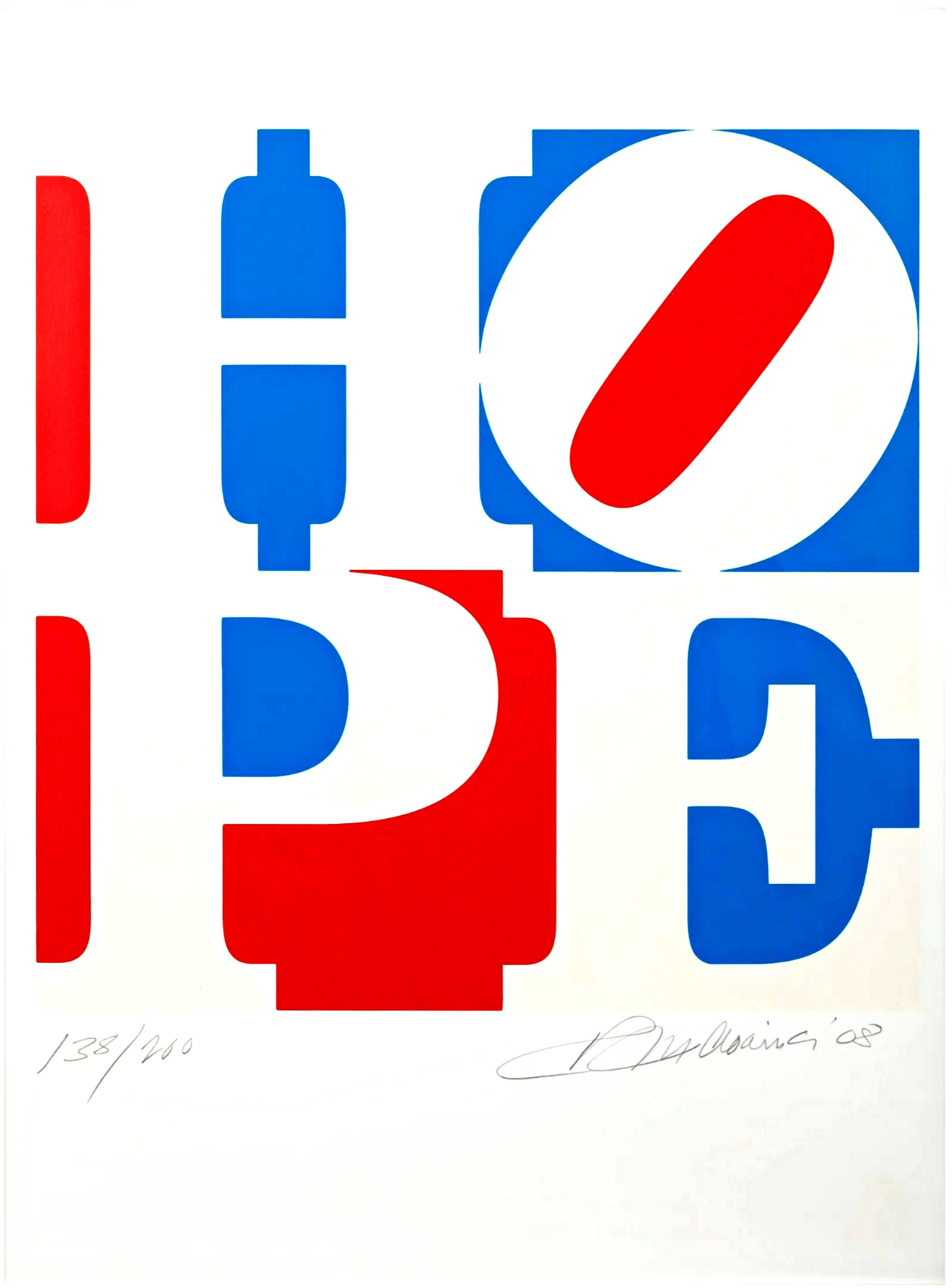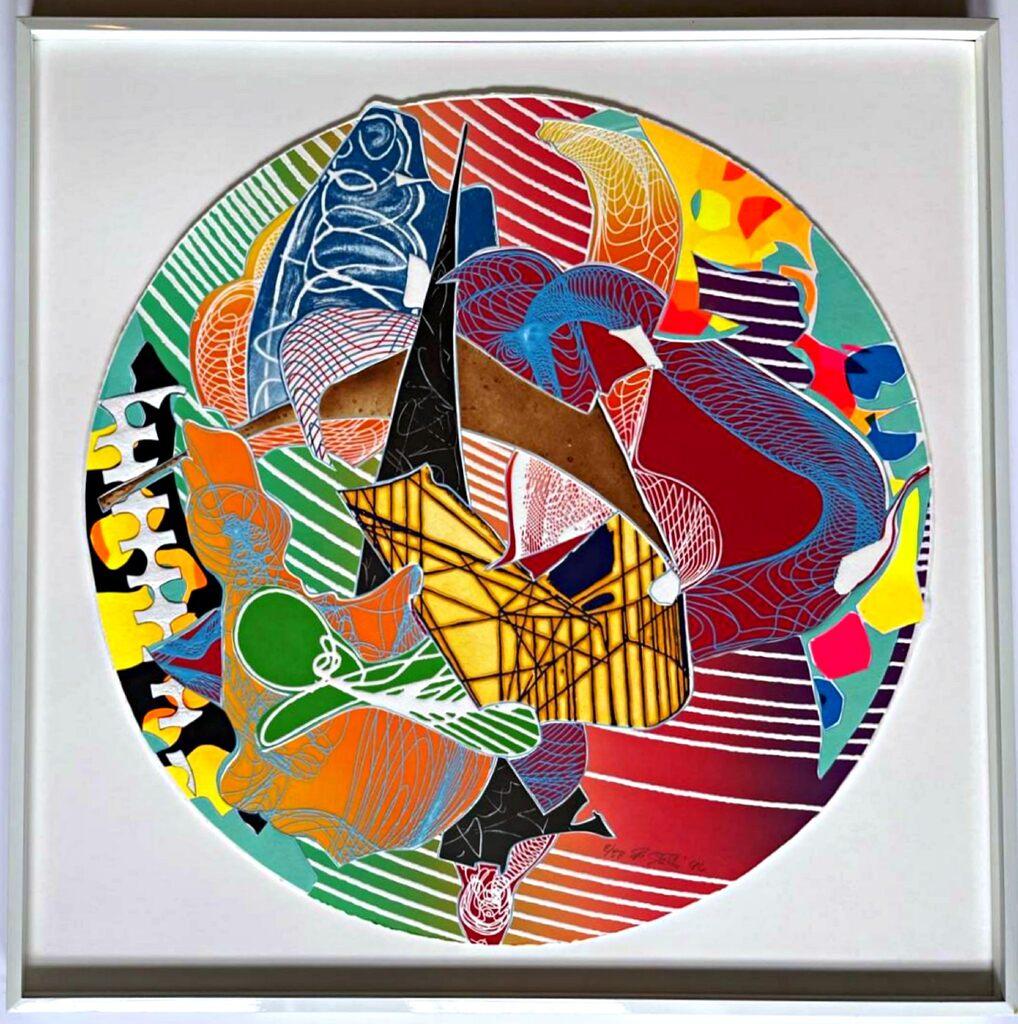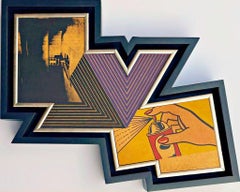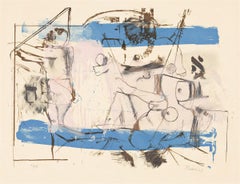Items Similar to Rare Op Art Mid Century Modern Geometric Abstraction 1960s Pop Art Signed 6/9
Want more images or videos?
Request additional images or videos from the seller
1 of 7
John GrilloRare Op Art Mid Century Modern Geometric Abstraction 1960s Pop Art Signed 6/9 1969
1969
About the Item
John Grillo
Untitled Op Art Mid Century Modern, 1969
Color silkscreen on art paper with deckled edges
Signed and dated lower right; numbered 6/9 lower left
Limited Edition of only 9
Unframed
The present work is a dazzling, extremely rare 1960s screenprint by Abstract Expressionist painter John Grillo, who died in 2014 at the age of 97. Hand signed and numbered from a small edition of only 9, it is a fusion of Op Art, Pop and Abstract Expressionist elements, in a vibrant palette anchored in red - a nod to the psychedelic colors of the late 1960s. It is in very good condition with deckled edges
John Grillo Biography
A leading exponent of Bay Area Abstract Expressionism during the 1940s, John Grillo was a painter, sculptor, and printmaker regarded as one the purest and most influential “action painters” on the West Coast. Though his diverse and colorful body of work ranged from abstraction to figuration, his art is considered linked in its uniquely aggressive and spontaneous approach. Grillo creates bold, fluid, gestural works such as Untitled #69 (1947) and Untitled (1949) that draw on the influence of Surrealist automatism. After moving to New York in 1948, Grillo began a series of paintings consisting of small, precisely organized colored squares, as seen in Untitled (1951) and Untitled (1959); these and other works were influenced by the color theories of Hans Hofmann, with whom he studied. Grillo’s later work was more figurative, but no less colorful, with works such as Blue Hat (1978) or Duerme (1980) recalling the Expressionism of Max Beckmann.
- Creator:John Grillo (1917, American)
- Creation Year:1969
- Dimensions:Height: 27.75 in (70.49 cm)Width: 22.5 in (57.15 cm)Depth: 0.1 in (2.54 mm)
- Medium:
- Movement & Style:
- Period:
- Condition:
- Gallery Location:New York, NY
- Reference Number:1stDibs: LU1745212955512
John Grillo
John Grillo 1917–2014 A leading exponent of Bay Area Abstract Expressionism during the 1940s, John Grillo was a painter, sculptor, and printmaker regarded as one the purest and most influential “action painters” on the West Coast. Though his diverse and colorful body of work ranged from abstraction to figuration, his art is considered linked in its uniquely aggressive and spontaneous approach. Grillo creates bold, fluid, gestural works such as Untitled #69 (1947) and Untitled (1949) that draw on the influence of Surrealist automatism. After moving to New York in 1948, Grillo began a series of paintings consisting of small, precisely organized colored squares, as seen in Untitled (1951) and Untitled (1959); these and other works were influenced by the color theories of Hans Hofmann, with whom he studied. Grillo’s later work was more figurative, but no less colorful, with works such as Blue Hat (1978) or Duerme (1980) recalling the Expressionism of Max Beckmann. 1947 Daliel Gallery 1960 Tanager Gallery
1961 The Howard Wise Gallery
1962 University of California, Berkeley
1964 Butler Institute of American Art
1969 Benedict Art Center
1970 Robert Dain Gallery
1973 Landmark Gallery
1982 Jean Lumbard Fine Arts
1984 Museo de Arte Moderna
2000 Aaron Gallery
1988 Provincetown Art Association Selected Group Exhibitions 1950 The Kootz Gallery
1955 Walker Arts Center
1953 Whitney Museum of American Art
1960 Walker Art Center
1961 Solomon R. Guggenheim Museum
1961 Yale University
1962 Dallas Museum of Fine Arts
1962 Seattle Worlds Fair
1963 Museum of Modern Art, New York
1963 San Francisco Museum of Modern Art
1970 The Brooklyn Museum of Art
1973 The Oakland Museum of California
1979 The Metropolitan Museum of Art
1996 The Laguna Beach Museum Selected Collections The British Museum The Metropolitan Museum of Art
The Solomon R. Guggenheim Museum of Art
The Whitney Museum of American Art
The Brooklyn Museum of Art
Walker Art Center
Los Angeles County Museum
Butler Institute of American Art
Bundy Art Gallery Museum
Smith College Museum
Bennington College
Portland Museum
About the Seller
5.0
Platinum Seller
These expertly vetted sellers are 1stDibs' most experienced sellers and are rated highest by our customers.
Established in 2007
1stDibs seller since 2022
354 sales on 1stDibs
Typical response time: <1 hour
- ShippingRetrieving quote...Ships From: New York, NY
- Return PolicyA return for this item may be initiated within 1 day of delivery.
Authenticity Guarantee
In the unlikely event there’s an issue with an item’s authenticity, contact us within 1 year for a full refund. DetailsMoney-Back Guarantee
If your item is not as described, is damaged in transit, or does not arrive, contact us within 7 days for a full refund. Details24-Hour Cancellation
You have a 24-hour grace period in which to reconsider your purchase, with no questions asked.Vetted Professional Sellers
Our world-class sellers must adhere to strict standards for service and quality, maintaining the integrity of our listings.Price-Match Guarantee
If you find that a seller listed the same item for a lower price elsewhere, we’ll match it.Trusted Global Delivery
Our best-in-class carrier network provides specialized shipping options worldwide, including custom delivery.More From This Seller
View AllBureau of Public Works (Mixed Media on Wood) Twice Signed Artists Proof Ed of 2
By Shepard Fairey
Located in New York, NY
SHEPARD FAIREY
Bureau of Public Works (on Wood), 2004
Mixed media silkscreen on wood panel. Hand signed and annotated on both the recto and verso. In original handmade artist's frame...
Category
Early 2000s Pop Art Mixed Media
Materials
Wood, Mixed Media, Pencil, Screen
Santa Fe Opera (Deluxe VIP Edition; Hand Signed & Numbered AP Edition of 50)
By Robert Indiana
Located in New York, NY
ROBERT INDIANA
Santa Fe Opera (Hand signed, numbered), 1976
Silkscreen on wove paper
37 1/2 × 27 inches
Edition AP 7/50
Hand Signed and dated lower rig...
Category
1970s Pop Art Abstract Prints
Materials
Screen, Pencil, Graphite
Democratic Party Human Rights Dinner (signed Pop Art print edition of only 100)
By Robert Rauschenberg
Located in New York, NY
Robert Rauschenberg
Human Rights Award, 1981
Silkscreen and Lithograph with Collage Embossing on Hodgkins Handmade Paper
Pencil signed and numbered 73/100 on the front
Silkscreen and Lithograph with Collage Embossing on Hodgkins Handmade Paper
Published by the Democratic Party...
Category
1980s Pop Art Abstract Prints
Materials
Pencil, Screen, Lithograph
Richard Pettibone The Appropriation Warhol, Stella, Lichtenstein, Unique Signed
By Richard Pettibone
Located in New York, NY
Richard Pettibone
The Appropriation Print Andy Warhol, Frank Stella, Roy Lichtenstein, 1970
Silkscreen in colors on masonite board (unique variant on sculpted board)
Hand-signed by artist, Signed and dated on the front (see close up image)
Bespoke frame Included
This example of Pettibone's iconic Appropriation Print is silkscreened on masonite board rather than paper, giving it a different background hue, and enabling it work to be framed so uniquely.
The Appropriation print is one of the most coveted prints Pettibone ever created ; the regular edition is on a full sheet with white background; the present example was silkscreened on board, allowing it to be framed in 3-D. While we do not know how many examples of this graphic work Pettibone created, so far the present work is the only one example we have ever seen on the public market since 1970. (Other editions of The Appropriation Print have been printed on vellum, wove paper and pink and yellow paper.)
This 1970 homage to Andy Warhol, Frank Stella and Roy Lichtenstein exemplifies the type of artistic appropriation he was engaging in early on during the height of the Pop Art movement - long before more contemporary artists like Deborah Kass, Louise Lawler, etc. followed suit.
This silkscreen was in its original 1970 vintage period frame; a bespoke custom hand cut black wood outer frame was subsequently created especially to house the work, giving it a distinctive sculptural aesthetic.
Measurements:
Framed 14.5 inches vertical by 18 inches horizontal by 2 inches
Work
13 inches vertical by 16.5 inches horizontal
Richard Pettibone biography:
Richard Pettibone (American, b.1938) is one of the pioneering artists to use appropriation techniques. Pettibone was born in Los Angeles, and first worked with shadow boxes and assemblages, illustrating his interest in craft, construction, and working in miniature scales. In 1964, he created the first of his appropriated pieces, two tiny painted “replicas” of the iconic Campbell’s soup cans by Andy Warhol (American, 1928–1987). By 1965, he had created several “replicas” of paintings by American artists, such as Warhol, Roy Lichtenstein (1923–1997), Ed Ruscha (b.1937), and others, among them some of the biggest names in Pop Art. Pettibone chose to recreate the work of leading avant-garde artists whose careers were often centered on themes of replication themselves, further lending irony to his work. Pettibone also created both miniature and life-sized sculptural works, including an exact copy of Bicycle Wheel by Marcel Duchamp (French, 1887–1968), and in the 1980s, an entire series of sculptures of varying sizes replicating the most famous works of Constantin Brancusi (Romanian, 1876–1957). In more recent years, Pettibone has created paintings based on the covers of poetry books by Ezra Pound, as well as sculptures drawn from the grid compositions of Piet Mondrian (Dutch, 1872–1944). Pettibone straddles the lines of appropriation, Pop, and Conceptual Art, and has received critical attention for decades for the important questions his work raises about authorship, craftsmanship, and the original in art. His work has been exhibited at the Institute for Contemporary Art in Philadelphia, the Museum of Modern Art in New York, the Museum of Contemporary Art in Miami, and the Laguna Art Museum in Laguna Beach, CA. Pettibone is currently based in New York.
"I wished I had stuck with the idea of just painting the same
painting like the soup can and never painting another painting.
When someone wanted one, you would just do another one.
Does anybody do that now?"
Andy Warhol, 1981
Since the mid-1960s, Richard Pettibone has been making
hand-painted, small-scale copies of works by other artists — a
practice due to which he is best known as a precursor of appropriation art — and for a decade now, he has been revisiting subjects from across his career. In his latest exhibitions at
Castelli Gallery, Pettibone has been showing more of the “same”
paintings that had already been part of his 2005–6 museum retrospective,1
and also including “new” subject matter drawn from
his usual roster of European modernists and American postwar
artists. Art critic Kim Levin laid out some phases of the intricate spectrum from copies to repetitions in her review of the
Warhol-de Chirico showdown, a joint exhibition at the heyday
of appropriation art in the mid-1980s when Warhol’s appropriations of de Chirico’s work effectively revaluated “the grand
old auto-appropriator”.
Upon having counted well over a dozen
Disquieting Muses by de Chirico, Levin speculated: “Maybe he
kept doing them because no one got the point. Maybe he needed the money. Maybe he meant it when he said his technique
had improved, and traditional skills were what mattered.”
On
the other side, Warhol, in her eyes, was the “latter-day exemplar
of museless creativity”.
To Pettibone, traditional skills certainly
still matter, as he practices his contemporary version of museless creativity. He paints the same painting again and again,
no matter whether anybody shows an interest in it or not. His
work, of course, takes place well outside the historical framework of what Levin aptly referred to as the “modern/postmodern wrestling match”,
but neither was this exactly his match
to begin with.
Pettibone is one of appropriation art’s trailblazers, but his diverse
selection of sources removes from his work the critique of the
modernist myth of originality most commonly associated with
appropriation art in a narrow sense, as we see, for example, in
Sherrie Levine’s practice of re-photographing the work of Walker
Evans and Edward Weston. In particular, during his photorealist
phase of the 1970s, Pettibone’s sources ranged widely across
several art-historical periods. His appropriations of the 1980s
and 1990s spanned from Picasso etchings and Brancusi sculptures to Shaker furniture and even included Ezra Pound’s poetry.
Pettibone has professed outright admiration for his source artists, whose work he shrinks and tweaks to comic effect but, nevertheless, always treats with reverence and care. His response
to these artists is primarily on an aesthetic level, owing much
to the fact that his process relies on photographs. By the same
token, the aesthetic that attracts him is a graphic one that lends
itself to reproduction. Painstakingly copying other artists’ work by hand has been a way of making
it his own, yet each source is acknowledged in
his titles and, occasionally, in captions on white
margins that he leaves around the image as an
indication that the actual source is a photographic image. The enjoyment he receives in copying
is part of the motivation behind doing it, as is
the pleasure he receives from actually being with
the finished painting — a considerable private
dimension of his work. His copies are “handmade
readymades” that he meticulously paints in great quantities in his studio upstate in New York; the commitment
to manual labor and the time spent at material production has
become an increasingly important dimension of his recent work.
Pettibone operates at some remove from the contemporary art
scene, not only by staying put geographically, but also by refusing to recoup the simulated lack of originality through the
creation of a public persona.
In so doing, Pettibone takes a real
risk. He places himself in opposition to conceptualism, and he is
apprehensive of an understanding of art as the mere illustration
of an idea. His reading of Marcel Duchamp’s works as beautiful
is revealing about Pettibone’s priorities in this respect.
When
Pettibone, for aesthetic pleasure, paints Duchamp’s Poster for
the Third French Chess...
Category
1970s Pop Art Abstract Prints
Materials
Masonite, Pencil, Screen
HOPE, signed and numbered silkscreen from Artists for Obama portfolio 138/200
By Robert Indiana
Located in New York, NY
Robert Indiana
HOPE for the Democratic National Committee, 2008
Oil silkscreen in colors on watermarked Coventry archival paper
25 × 19 inches
Ed...
Category
Early 2000s Pop Art Abstract Prints
Materials
Pencil, Screen
Plutusia, from Imaginary Places II (Axsom 246). hand signed/N, Framed
By Frank Stella
Located in New York, NY
Frank Stella
Plutusia, from Imaginary Places II (Axsom & Schnitzer, 246), 1996
52 color lithograph, screenprint, etching, aquatint, relief, mezzotint, engraving on white TGL handmade paper. Accompanied by the original documentation sheet on the back, hand signed by both Frank Stella and Kenneth Tyler
Signed and dated in pencil, lower right; Tyler Graphics (TGL) blind stamp lower center. Workshop number inscribed in pencil verso FS94-3123, Edition 8/38.
Frame included: elegantly floated and framed in a white wood frame with UV plexiglass
Signed and dated in pencil, lower right; Tyler Graphics (TGL) blind stamp lower center. Workshop number inscribed in pencil verso FS94-3123; numbered 8/38 on the front (there were also 12 Artists Proofs)
Accompanied by the original documentation sheet on the back, hand signed by both Frank Stella and Kenneth Tyler
Catalogue Raisonne Reference: Axsom & Schnitzer, 246
Published by Tyler Graphics, Inc., Mt. Kisco New York
Measurements:
Framed:
30.5 inches (vertical) x 30 inches (horizontal) x 2 inches (depth)
Artwork alone:
26.5 inches diameter
"Plutusia" is the second part of a series of works Stella did called "Imaginary Places". According to the catalogue raisonne, "the titles of these works came from The Dictionary of Imaginary Places by Alberto Manguel and Gianni Guadalupi. Fashioned in the spirit of nineteenth-century traveler's guides, the book is a catalogue of fictional locations culled from world literature...
Category
1990s Pop Art Abstract Prints
Materials
Foil
You May Also Like
Purim
By Larry Rivers
Located in New York, NY
A very good impression of this scarce, early color lithograph with additions in pencil and crayon on Auvergne à la main (Richard de bas) ivory laid paper. Signed, dated and numbered 15/45 in pencil, lower margin. Printed by Robert Blackburn...
Category
1960s Pop Art Abstract Prints
Materials
Crayon, Pencil, Color, Lithograph
$3,500
Falling man going abstract, Geometric Abstract Screenprint by Ernest Tino Trova
By Ernest Tino Trova
Located in Long Island City, NY
Artist: Ernest Tino Trova, American (1927 - 2009)
Title: Falling man going abstract
Year: 1969
Medium: Silkscreen, signed and numbered in pencil
Edition: 6...
Category
1960s Pop Art Abstract Prints
Materials
Screen
"Four Square", Serigraph from the American Dream Portfolio by Robert Indiana
By Robert Indiana
Located in Long Island City, NY
Artist: Robert Indiana, American (1928 - 2018)
Title: 4 Square from the American Dream Portfolio
Year: 1963 (1997)
Medium: Screenprint
Edition Size: 395 (unnumbered)
Image Size: 14 x...
Category
1960s Pop Art More Prints
Materials
Screen
Cracker Jack, Pop Art Serigraph by Bob Stanley
Located in Long Island City, NY
Artist: Bob Stanley, American (1932 - 1997)
Title: Cracker Jack
Year: 1972
Medium: Serigraph, signed and numbered in pencil
Edition: 150; AP XII
Image Si...
Category
1970s Pop Art Abstract Prints
Materials
Screen
The Santa Fe Opera, Serigraph by Robert Indiana
By Robert Indiana
Located in Long Island City, NY
Artist: Robert Indiana
Title: The Santa Fe Opera
Year: 1976
Medium: Serigraph, signed and numbered in pencil
Edition: 250
Paper Size: 38 in. x 24 in. ...
Category
1970s Pop Art Abstract Prints
Materials
Screen
Robert Indiana, "Decade Autoportrait", from the American Dream Portfolio
By Robert Indiana
Located in Long Island City, NY
Artist: Robert Indiana, American (1928 - 2018)
Title: Decade Autoportrait from the American Dream Portfolio
Year: 1977 (1997)
Medium: Serigraph
Edition: 395
Image Size: 14 x 14 inche...
Category
1970s Pop Art Abstract Prints
Materials
Screen
Recently Viewed
View AllMore Ways To Browse
Midcentury Geometric Signed
Midcentury Screen Geometric
1960s Dior Hat
John Grillo On Sale
Dali Tristan Isolde
Damien Hirst Forever Large
Damien Hirst Fruitful Large
Dior Beach Towel
Dress Oy
E Brodsky
Edwin James Douglas
Enrique Carbajal Sebastian
Espo Art
Fernando Botero Bird
Frank Stella Polar
Frank Stella Sinjerli
Frank Stella Whale
G Hopkins Paintings
